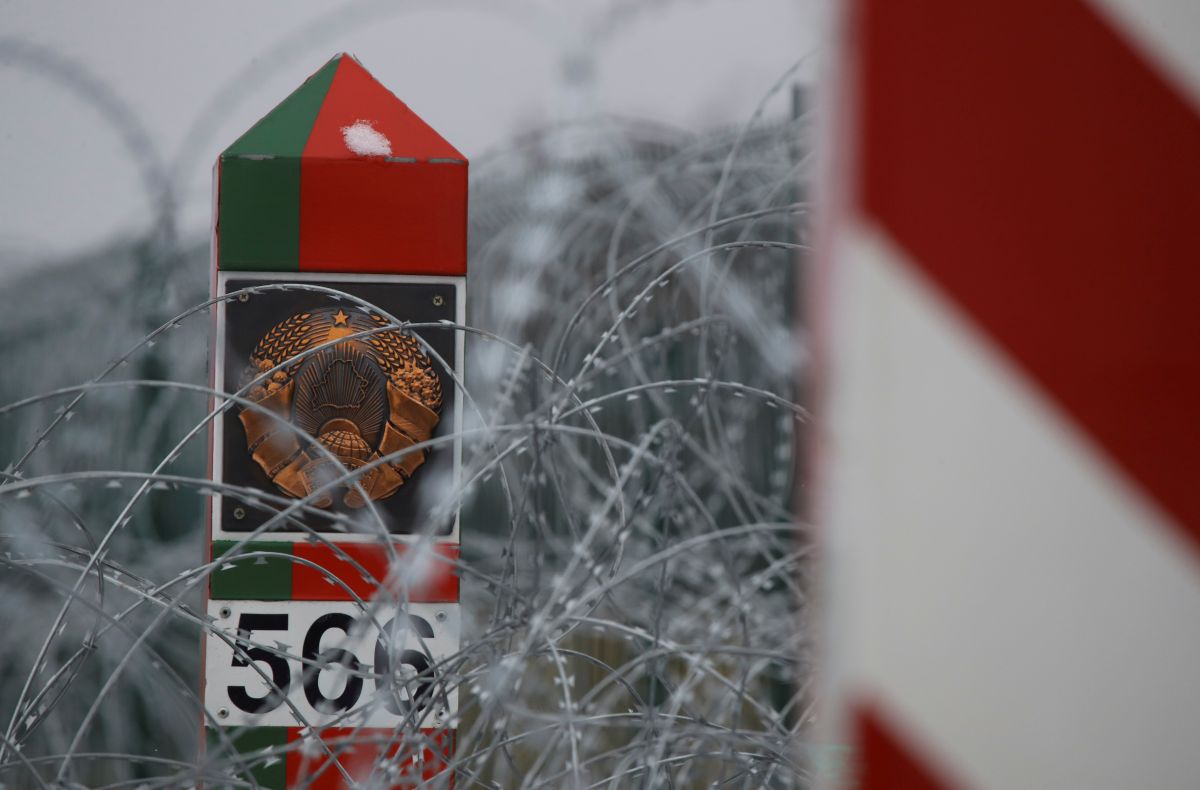Russian and Belarusian Disinformation and Propaganda in the Context of the Polish-Belarusian Border Crisis
Russia and Belarus are consistent in their narrative regarding the recent border crisis. They accuse EU and NATO members, mainly Poland and Lithuania, of failing to respect international law and lacking humanity. This is aimed at discrediting Euro-Atlantic structures and weakening Polish and Lithuanian influence on NATO and EU eastern policy. The Belarusian-Russian propaganda particularly invokes charges of hypocrisy and “double standards” on the part of the EU, which challenges the management and resolution of the border crisis.
 Photo: KACPER PEMPEL/Reuters/Forum
Photo: KACPER PEMPEL/Reuters/Forum
The crisis at the Polish-Belarusian border provoked by the Belarusian regime of Alexander Lukashenka poses a challenge to European security. In the beginning of this year, Belarus eased visa regulations for people coming from the Middle East, and Belarusian travel agencies have been offering transportation as part of a “new migration route” to the EU. First, the Baltic States and, since August, Poland have been confronted with an increase in irregular border crossings and attempts to enter the Schengen area by force.
Belarus and Russia’s Goals
The states have the common objectives to reinforce divisions within the EU by polarising societies and pitting the Member States against each other, and to destabilise NATO’s Eastern Flank and test the crisis-response capabilities of these organisations. At the same time, Belarus and Russia seek to limit the influence of Poland and Lithuania on EU and NATO eastern policy over these member states’ support for Belarusian civil society and demands for tougher sanctions on Belarus and Russia. Furthermore, Lukashenka and Putin are keen to divert attention from the growing legitimacy crisis in their own countries.
However, Belarus and Russia are not fully aligned. Lukashenka seeks to escalate the crisis and provoke the EU states to use force against the migrants in order to discredit the Union in disinformation messaging. Lukashenka’s aggressive rhetoric is also intended to urge Russia to support his position in Belarus. Russia is keen to maintain the tension, but without escalating it, seeking to act as a mediator and guarantor of stability in the post-Soviet region. Like the situation with Ukraine, this position is intended to induce EU states to initiate talks with Russia on European security and to consider its demands regarding the regulation of crises in Russia’s neighbourhood. The latter’s propaganda on the border issue is intended to persuade Western states that increased Russian influence in Belarus will reduce Lukashenka’s adventurism.
Convergence of Propaganda Actions
Belarusian and Russian media share a common narrative on the crisis on the Poland-Belarus border. They focus on a one-dimensional view of the humanitarian issues and accuse NATO member states of interventions (e.g., in Afghanistan and Iraq) that have deliberately directed migrants to Belarus in order to destabilise it and provoke conflict by arming migrants, an unfounded claim. An example of the convergence of the disinformation activities of Russia and Belarus is the cooperation between journalists from these states reporting on the crisis at the border.
However, the Russian propaganda is less radical than the Belarusian. Russian journalists do not avoid criticising the actions of the Lukashenka regime, thanks to which Russia can create an image in the eyes of Western countries as a “constructive partner”, and one that could mediate talks between Belarus and the EU. The head of Russian diplomacy, Sergei Lavrov, called on the EU to provide financial support (€500 million) to Belarus to assist the migrants, similar to the 2016 agreement between the EU and Turkey. President Vladimir Putin’s spokesman Dmitry Peskov has offered Russian mediation in the talks between the EU and Belarus, which was kept out of Belarusian media.
The disinformation targeting Poland is fuelled by provocations by Belarusian services, which accuse Polish personnel at the border of using explosives and toxic substances against migrants, as well as torture and inhumane treatment (e.g., sleep deprivation, blinding with lights or lasers). In fact, it was Belarus that equipped migrants with stun grenades, which were then thrown towards the Polish border, and Belarusian border guards who used lasers and stroboscopes to try to blind Polish personnel. This disinformation is further reinforced by Belarus initiating an investigation into crimes against humanity allegedly committed by the Polish officers and soldiers protecting the border. Belarusian investigators are also spreading false information about Polish security services dumping migrants’ corpses on Belarusian territory. Lukashenka’s two talks with then Chancellor Angela Merkel was used by Belarusian media in disinformation suggesting that Germany had agreed to the creation of a “humanitarian corridor” through Poland.
How Disinformation is Spread Abroad
The leading centres in promoting disinformation concerning the border crisis are Belarusian government media (including BelTa, Belarussia-1, ONT, CTV) and Russian government media (including Rossiya 1, Perviy kanal, RIA Novosti, TASS, Lenta, Ritm Evrazii, Regnum). The rhetoric they formulate is distributed via social networks (e.g., Telegram) and various language versions (including Arabic) of Russian disinformation portals (e.g., RT, Sputnik, BaltNews, RuBaltic). Lukashenka has also tried to strengthen the reach of his propaganda by inviting Western journalists to the Belarusian side of the border and giving interviews to American and British television, then presenting the material they publish in a manipulated way in Belarusian media.
The disinformation activities undertaken by Belarus and Russia have a limited impact on Western media, which present the situation on the Polish-Belarusian border in an objective and balanced way. Articles reproducing untruths, inspired by Russia and Belarus, appear only in niche portals with a clear pro-Russia affiliation. The limited effectiveness of the disinformation on a broader scale testifies to the lack of credibility of Belarusian and Russian media. The strengthening of Western media’s resistance to false and manipulated information indicates progress in countering and combating disinformation compared to the period of Russian aggression against Ukraine (particularly in 2014/2015). This is the result of activities at the state level (special state structures), among societies (non-governmental initiatives), as well as internationally (e.g., EU StratCom East). Consistent and unambiguous messages from NATO and EU member states and representatives of these organisations have also been an important component of the strategic communication. Migration pressure from Belarus and accompanying disinformation activities are considered hybrid actions taken directly against Poland, Lithuania, and Latvia.
Conclusions
The activity of Russia and Belarus in disseminating disinformation regarding the border crisis has so far failed to achieve the expected results, mainly the creation of internal divisions within the EU and NATO and the weakening of sanctions against Belarus. Lukashenka’s attempt to use irregular migration to blackmail Euro-Atlantic structures has instead resulted in further securitisation of the border, and especially in media and political rhetoric. However, given that the border crisis will be prolonged, Belarusian propaganda emphasising the supposed brutality of the Polish and Lithuanian authorities towards migrants may gain prominence in some foreign media. It is unlikely that the Belarusian disinformation that the border crisis is inspired by EU states against Belarus will gain traction. On the other hand, the rhetoric repeated by Russia and Belarus about the EU being an organisation with “double standards” will contribute to a negative perception of the bloc in the Russian-speaking media, mainly in former Soviet states. The Russian propaganda will change depending on Russia-Belarus relations, but it will not stop seeking to undermine the EU’s ability to manage future crises.
Despite fewer irregular migrants trying to cross the border, the number of weather-related deaths is likely to increase, which will in turn lead to further Belarusian and Russian accusations that Poland and the EU are not complying with international law. It would be beneficial to thwart this by increasing the level of transparency of government actions on the border, which should weaken the influence of the Belarusian-Russian disinformation. It is also worth considering allowing more foreign journalists and media on the EU side of the border to counteract the rhetoric of the Russian and Belarusian propaganda.



